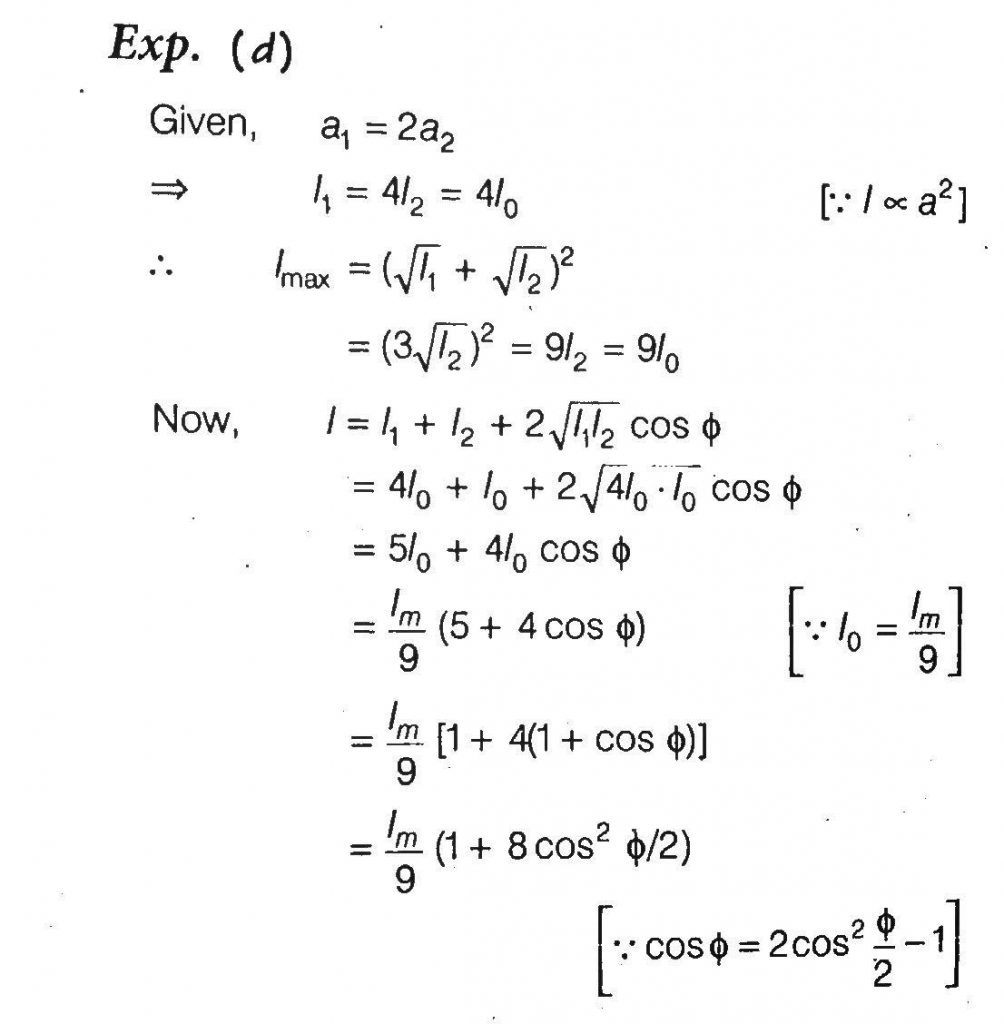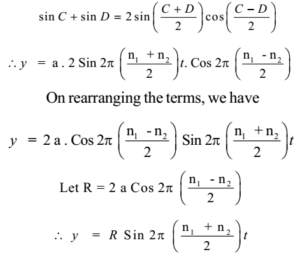Resultant Amplitude And Intensity
Resultant Amplitude and Intensity Intensity if the power transferred per unit area that is perpendicular to the direction of propagation of the energy. Find resultant amplitude and intensity at a point where a.
Learn Intensity Of Superimposing Wave In 2 Minutes
B path difference between two waves is lambda3.

Resultant amplitude and intensity. List 1 Resultant amplitude for theta60. The first wave lags behind in phase angle from second and third wave. Please like subscribe and share For feedback and help.
14 mathrmD and 14 mathrmJ. The amplitude of the resultant wave is Ar3A A r 3 A and its intensity is IrcA2r3cA23I0 I r c A r 2 3 c A 2 3 I 0. Here the videos of each chapter will be given in the form of pl.
The intensity is proportional to the square of the amplitude so where is the intensity at the center of the pattern. Watch Video in App. What is that largest amplitude.
Each wave is a periodic disturbance. Two waves of amplitude 1 m that are equal in every way have. Using vector diagrams find the resultant amplitude and intensity in the interference pattern from a Fabry-Perot interferometer having a reflectance of 800 percent when the phase difference between successive rays is a 0circb 150circ and c 300circ see Figs.
As the intensity is proportional to the square of the amplitude the resultant intensity will also vary and it will be maximum when R is maximum. One may say that two sources will produce double the power so double the intensity. The form of the equation shows that the resultant motion is also a Simple Harmonic Wave of mean frequency but its amplitude R changes with time.
Resultant intensity for theta90circ Resultant intensity for theta0circ List 2 2 time 3 time 4 time None. Find resultant intensity at. Resultant amplitude of each is A_0.
The displacement y2 and y3 have a phase difference of 3 3. This browser does not support the video element. Note that y1 and y4 are out of phase and interfere destructively.
To keep watching this video solution for FREE Download our App. Find resultant amplitude and intensity at a point where a phase difference between two waves is 60. Given Amplitude of waves AIntensity ITo find Resultant amplitude and intensity at a point where phase difference between two waves is 60path differenc Aryangupta498 Aryangupta498 26032020 Physics Secondary School answered In interference two individual amplitudes are A_0each and the intensity is I_0each.
If intensity due to each source is I0 12 Wm2 at P and d22D 3 calculate the resultant intensity at P. Another may say that the two waves superposing in phase will produce double the amplitude so four times the initial intensity. Problem 7 Easy Difficulty.
Watch 1 minute video. Two sinusoidal waves of the same frequency are to be sent in the same direction along a taut string. Physics ICU has been created for uploading all academic videos on Physics in Bangla language.
Each wave has an amplitude of 700 cm. Join the 2 Crores Student community now. Amplitude determines the loudness of a wave.
Greater the amplitude. Intensity is directly proportional to square root of the amplitude. Intensity corresponding to A_0 is I_0.
One wave has an amplitude of 5. 0 m m the other 8. Find the amplitude of the resultant wave.
What happens if the amplitude of a wave is doubled. Phase difference between first wave and second wave is 60. I I1I2 2I1I2cosx Where Inet intensity xphase difference So I thought of calculating the path differences between all the 3 points by taking them in pairs of 2.
Resultant Amplitude and Intensity of Two waves in Wave Optics for JEE and NEET is the topic of this physics video lesson. S1 and S2 S2 and S3 S3 and S1 I got the path differences as 3 and 23 I can now find. Path difference between first wave and third wave is lambda3.
Which one is correct. What is the resultant intensity. This equation relates the amplitude of the resultant field at any point in the diffraction pattern to the amplitude at the central maximum.
So if intensity becomes double then amplitude will become four times.

The Resultant Amplitude Of A Vibrating Particle By The Superposition Of The Two Waves Y1 A Sin W T Pi3 And Y2 A Sinw T Is

Superposition Of Waves Principle Constructive Destructive Interference
Describe Analytically Phenomenon Of Interference Of Light And Explain Constructive And Destructive Interference Sarthaks Econnect Largest Online Education Community
Learn Intensity Of Superimposing Wave In 2 Minutes

In Interference Two Individual Amplitudes Are A 0 Each And The Intensity Is I 0 Each Find Resultant Amplitude And Intensity At A Point Where A Phase Difference Between Two Waves Is 60 B

Resultant Amplitude And Intensity Of Two Waves In Wave Optics For Jee And Neet Youtube

Numerical Question Of Finding Intensity Of Resultant Wave In Urdu Hindi Youtube

Resultant Amplitude An Intensity At Any Point In Double Slit Experiment Youtube

Interference Of Sound Waves Ppt Video Online Download

In A Young S Double Slit Experiment One Of The Slit Is Wider Than Other So That Amplitude Of The Light From One Slit Is Double Of That From Other Slit If Im

Two Sinusoidal Waves Of Intensity I Having Same Frequency And Same Amplitude Interferes Constructively At A Point The Resultant Intensity At A Point Will Be

Three Waves From Three Coherent Sources Meet At Some Point Resultant Amplitude Of Each Is A 0 Intensity Corresponding To A 0 Is I 0 Phase Difference Between First Wave And Second Wave Is 60

Chapter 11 Superposition Of Light Wave When Two Waves

Three Waves From Three Coherent Sources Meet At Some Point Resultant Amplitude Of Each Is A 0 Youtube

Formation Of Beats Meaning Of Beats Expression For Period And Frequency
Resultant Amplitude And Intensity Myrank

10b11ph111 Wave Physical Optics Modern Physics Interference Ppt Download
Two Waves Of The Same Frequency And Same Amplitude Are Reaching A Point Simultaneously What Should Be The Phase Difference Between The Waves So That The Amplitude Of The Resultant Wave Is 2a


Posting Komentar untuk "Resultant Amplitude And Intensity"